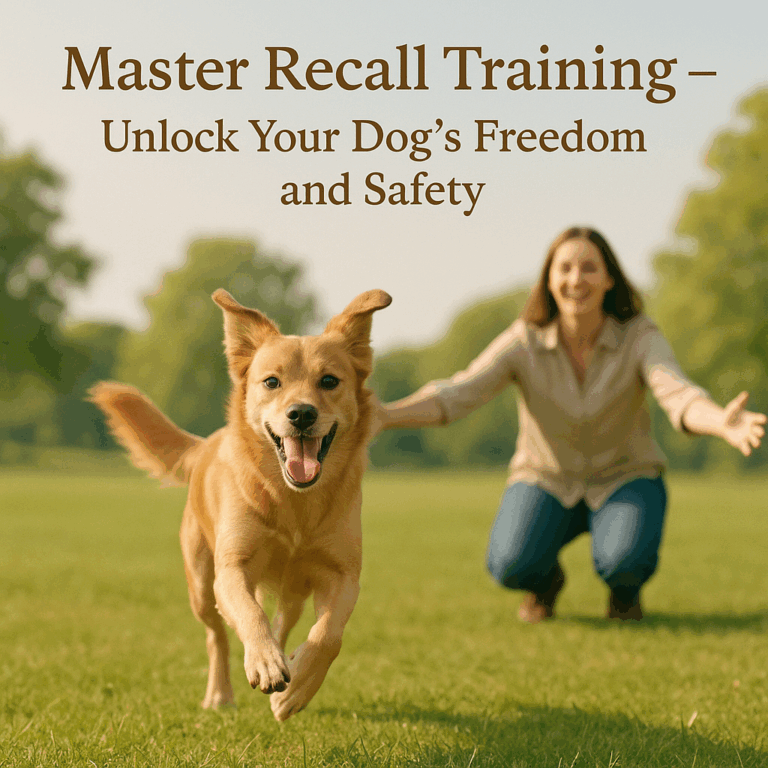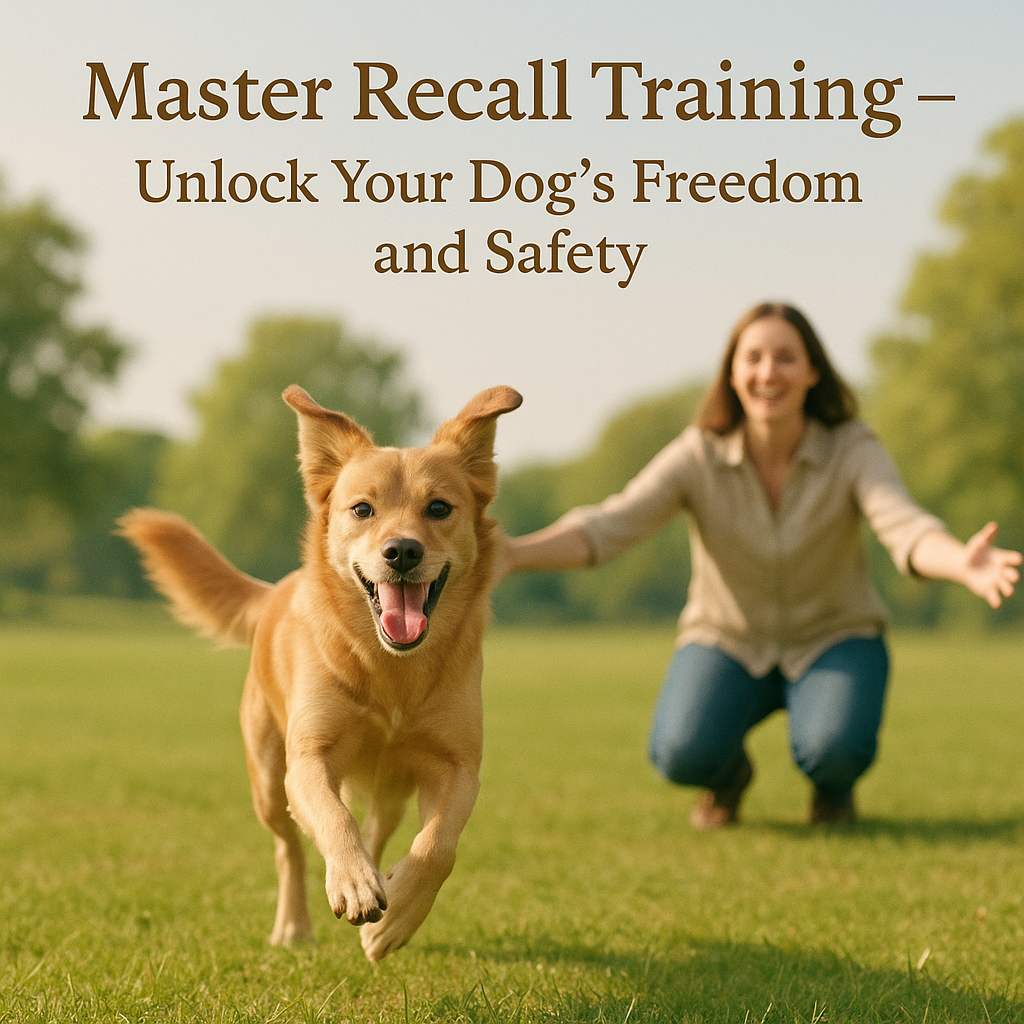Mastering Recall: The Golden Key to Your Dog’s Freedom and Safety
If you’ve ever watched your dog bolt with boundless joy upon hearing the word “walk” or seen a puppy chase a squirrel with wild abandon, you know how ecstatic and unpredictable our furry pals can be. There’s a special magic in watching their enthusiasm—but there’s also a bit of heart-stopping panic when that joyous sprint turns into a dash toward the unknown. That’s why **recall training**—getting your dog to come back when called—is one of the most vital skills you’ll ever teach your pup. It’s a mixture of safety, joy, and trust all wrapped up in one simple command.
Why Recall Is Your Dog’s Superpower
Imagine this: you’re at the dog park, your dog off-leash, sniffing and mingling. Suddenly, a squirrel darts by, and your dog’s prey drive kicks in. Without a reliable recall, you’re chasing a blur of fur across the park, heart pounding as you call their name again and again. Now, picture a different scene: you say your dog’s name, “Charlie, come!” and like a magnet, Charlie bounds back to your side with ears flapping and tail wagging. Not only will recall save your dog from dangerous situations—think traffic, unfriendly animals, or strangers—but it’s also your ticket to letting them safely enjoy more freedom and adventure.
Start Early and Keep It Positive
Recall training is best started as early as possible. Puppies have spongy brains soaking up new info like little treat-stealing ninjas at the kitchen counter. Begin indoors or in a quiet, enclosed yard to remove distractions. Use a happy, enthusiastic voice because dogs are emotional creatures—if you sound fun and excited, they’ll want to come to you just as much as a slice of their favorite roast chicken.

Timing is everything. Rewarding your puppy immediately with a delicious treat, tickle, or toy when they come makes recall a joyful game. A big mistake many make is calling their dog only when it’s time to go inside or end fun—this sets recall up as a negative experience. Instead, call your dog often during play to reward their return with more fun.
Tools of the Trade: Leashes, Collars, and ID Tags
Every trainer’s arsenal includes some trusty equipment to keep things safe and effective. A **dog collar** is essential, and I always recommend one that you can comfortably slip a finger underneath—neither too tight nor too loose. A well-fitted collar is vital for attaching an **ID tag** that carries your pup’s vital information. Why is this so crucial? Even with perfect recall, accidents happen—dogs get startled, distracted, or lost. A high-quality ID tag increases the chances your dog will find their way back home if they ever get separated from you.
For training sessions, a standard 15-20 foot long leash or a training lead gives your dog the freedom to explore but still keeps them within your control. Avoid retractable leashes during recall training—they encourage pulling and often lead to frustration for all involved.
Step-by-Step Recall Training
1. **Choose a clear, consistent command:** “Come,” “Here,” or even a unique whistle. The key is to stick with one word or sound to avoid confusing your dog.
2. **Use high-value rewards:** Think smelly cheese, tiny bits of chicken, or a favorite squeaky toy. Your dog’s favorite goodies create motivation that can’t be beat.
3. **Make it a game:** Start at short distances. Call your dog with excitement, then reward lavishly when they reach you. Gradually increase the distance.
4. **Add distractions slowly:** After your dog masters recall in quiet environments, practice near distractions like other people or pets. It’s harder but essential.
5. **Never punish a dog who comes:** This breaks trust and can sabotage your progress. Even if your dog took its sweet time, celebrate the moment they come.
Common Recall Pitfalls and How to Fix Them
Dogs aren’t born with recall skills—they learn through practice (and sometimes through trial and error). Here are common stumbling blocks and tricks to smooth the road:
– **Dog ignores your call:** This often means the recall isn’t rewarding enough. Pump up the value of treats, use your happiest voice, or try a fun game immediately after.
– **Dog comes but then bolts again:** Teach a “stay” or “wait” command alongside recall. Reward your dog for staying close and calm after they arrive.
– **Dog afraid to come:** If your dog hesitates, make sure you’re not unknowingly scolding them when they arrive. Practice recall only during happy times until their confidence builds.
– **Too many distractions:** Break training into bite-sized chunks. It’s better to succeed with a few distractions than fail dramatically in a noisy park.
Safety First: Grooming, Health, and Comfort for Recall Success
Great recall depends on a happy and healthy dog. Regular **pet care** ensures your dog isn’t hampered by physical discomfort. Check their paws for cuts after runs, keep nails trimmed to avoid injury, and ensure their coat doesn’t get matted, which can cause irritability. Make sure your dog is hydrated and not overheated during play sessions—nothing kills enthusiasm faster than a thirsty or tired pup.
Also, review your **dog collar** regularly. Collars can wear down, and rings can loosen—things to check before every walk. A secure buckle and a clear, legible **ID tag** are non-negotiable.
From Puppy to Pro: Turning Recall into a Lifelong Habit
Recall is not something you finish and forget. It requires consistency—think of it as ongoing communication. Even after mastering recall, call your dog frequently during interactions, reward them for coming, and keep the game alive. As your dog matures, they’ll become your trusted companion—not just for safety, but for shared adventures that fill your days with joy.
Remember, as famed dog trainer Cesar Millan once said, “The bond with a true dog is as lasting as the ties of this earth will ever be.” Teaching your dog to come when called isn’t just training—it’s strengthening that unbreakable bond, stitch by stitch, one happy run at a time.
Tags: dog behavior training, dog freedom and safety, dog obedience training, dog recall commands, dog recall training, dog safety tips, importance of dog recall, puppy recall techniques, teaching dog to come, training dogs to come back